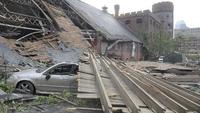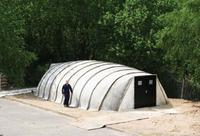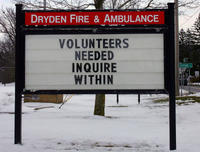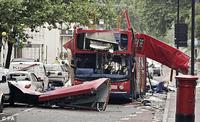-
Deadly tornado kills four in Massachusetts

On Wednesday, as many as seven tornadoes tore through Massachusetts resulting in the state’s first twister related deaths in sixteen years; the tornadoes touched down in the western and central part of the state, but hit Springfield, located ninety miles west of Boston, the hardest; more than forty people have been admitted to hospitals after sustaining injuries from the tornado and four people have been confirmed dead so far; emergency responders are currently picking through the wreckage to rescue any survivors trapped in the rubble
-
-
Local emergency responders in Michigan could receive new radio system
Local emergency responders in Michigan could soon be receiving new communication equipment to connect with other nearby agencies; city councils in Grosse Pointes and Harper Woods are currently considering whether to purchase new radios to replace their aging 800 MHz system; a $485,000 DHS grant could help fund the purchase of the new radios which would cost more than $1 million to purchase
-
-
Disaster relief innovation: concrete tent

Among innovations which could help relief efforts following major disasters is a fabric shelter that, when sprayed with water, turns to concrete within twenty-four hours; the system works by impregnating cement particles into a fabric from which the tent is made; when the folded tent arrives at the disaster area, it is unrolled, tacked down with stakes, and then filled with air via a fan; once in place, the tent is soaked with water and then left to dry for twenty-four hours; once the concrete hardens, the tents can last for up to ten years; the tents come with installable doors, and since the walls are hard, electrical outlets and plumbing pipes can also be installed
-
-
Grand Junction, Colorado uses DHS grant to purchase bomb squad equipment
The Grand Junction Police Department in Colorado recently received two grants to purchase sophisticated new equipment for its bomb squad and new information sharing software; on Monday, the city council authorized the police department to accept the two grants; thanks to a $250,000 grant from DHS, the police department will now be able to purchase a Total Containment Vessel (TCV); Grand Junction also received a $108,000 grant from the Colorado Association of Chiefs of Police to purchase new software
-
-
New York firefighters receive $4.2 million to recruit volunteers

Last week the Fireman’s Association of the State of New York (FASNY) announced that it had received a $4.2 million grant from DHS to help recruit and train volunteers; the money comes as part of DHS’ Staffing for Adequate Fire and Emergency Response (SAFER) grant program; FASNY will use the grant money to launch a public awareness campaign with the goal of attracting and maintaining more than 15,000 new volunteer firefighters over the next four years; approximately 75 percent of New York’s firefighters are volunteers, but the state has struggled to attract enough people in recent years
-
-
West Virginia lottery winner donates $1 million to local police and fire departments
After winning the lottery, a West Virginia resident has donated nearly $1 million to local police and fire departments; last Thursday, W. Randy Smith purchased six Ford F-350 pickup trucks equipped with snow plows and snow blowers for six fire departments in Berkeley County; Smith says he decided to purchase the vehicles after severe winter storms last year left many emergency vehicles unable to reach their destinations; Smith’s generosity comes after winning nearly $80 million last August in the Powerball lottery; Smith has also made several other donations including new four wheel drive ambulances for the Hedgesville and Baker Heights fire departments which cost $280,000
-
-
New York first in nation to deploy PLAN emergency alert system

New Yorkers will be the first in the United States to have a new emergency alert notification system available to them; the program is called PLAN, for Personal Localized Alerting Network; PLAN is a new public safety system that allows customers who own an enabled mobile device to receive geographically targeted, text-like messages alerting them of imminent threats to safety in their area; users should expect several kinds of alerts: warnings directly from President Obama, messages about immediate safety threats, and Amber Alerts about missing kids
-
-
Students develop better security system for retailers
Northeastern University student-researchers have created technology designed to gather more meaningful information on customer habits, inventory, and fire safety in retail stores such as CVS, Stop & Shop, and The Home Depot; the students used the university library as a mock retail store; the technology they developed displays all of the information — including the location of books, computers, and fire alarms — on digitized heat maps with geographic coordinates; the system could make for a strong fire safety application
-
-
Tiltable-head robots adept at navigating disaster debris

Search and rescue missions have made the headlines in the last eighteen months, following the earthquakes in Haiti and Chile, the floods in Pakistan and New Zealand, and the tsunami in Japan; machines able to navigate through complex dirt and rubble environments could have helped rescuers after these natural disasters, but building such machines is challenging; Georgia Tech researchers have now built a robot that can penetrate and “swim” through granular material
-
-
7/7 attacks could not have been prevented: report

An inquest into the 7 July 2005 attack on London transportation concluded that any suggestion MI5 could have stopped the attacks was “based to a considerable extent on hindsight”; there were failures in the response by emergency workers — confusion, a shortage of first aid supplies, and radios that did not work underground, but the report concludes that government errors had not increased the death toll
-
-
Search-and-rescue robot operators get better with practice
Urban search and rescue (USAR) task forces are essential for locating, stabilizing, and extricating people who become trapped in confined spaces following a catastrophic event; sometimes the search area is too unstable for a live rescue team, so rescuers have turned to robots carrying video cameras; trouble is, research shows that more often than not, the human beings who remotely operate the robots have a view of their robot-control skills which is at variance with reality, causing robots to get stuck
-
-
Philadelphia police hold emergency exercise
On Wednesday morning the Philadelphia police department held a training exercise to help prepare officers to respond during a terrorist attack; starting at 10:30 AM roughly 50 officers gathered on 22nd Street and JFK Boulevard where they were given assignments, briefed, and eventually deployed to cover different sections of Center City; The drill involved members of the department’s Homeland Security Unit and was a rapid deployment exercise that reflected Philadelphia’s heightened level of awareness following the death of Osama bin Laden
-
-
Improving safety in the presence of chemical hazards
A new kind of sensor could warn emergency workers when carbon filters in the respirators they wear to avoid inhaling toxic fumes have become dangerously saturated; first responders protect themselves from such vapors, whose composition is often unknown, by breathing through a canister filled with activated charcoal — a gas mask; airborne toxins stick to the carbon in the filter, trapping the dangerous materials, and as the filters become saturated, chemicals will begin to pass through; the respirator can then do more harm than good by providing an illusion of safety
-
-
DHS IG criticizes FEMA's IT systems
DHS Inspector General says that FEMA’s IT systems “do not support disaster response activities effectively”; the IG recommends that FEMA develop a comprehensive IT strategic plan with clearly defines goals and objectives to support program IT initiatives, and that FEMA establish an agency-wide IT budget planning process to include all FEMA program technology initiatives and requirements
-
-
Missouri pounded by rains and tornadoes, thousands evacuate
This week heavy rain storms are raging across the mid-west and south forcing thousands of residents in Missouri to flee as swollen rivers threaten to flood their homes; in some areas emergency responders do not have many options and can do nothing but hope that the levees hold; the mid-west will not see any respite from the storms until Thursday as another major storm system is about to hit; officials are bracing for substantial flooding; the region is still struggling to recover from major storms that spawned tornadoes in six states killing forty-five people and damaging structures; Missouri has requested aid from the Federal Emergency Management Agency
-
More headlines
The long view
Using Drone Swarms to Fight Forest Fires
Forest fires are becoming increasingly catastrophic across the world, accelerated by climate change. Researchers are using multiple swarms of drones to tackle natural disasters like forest fires.
